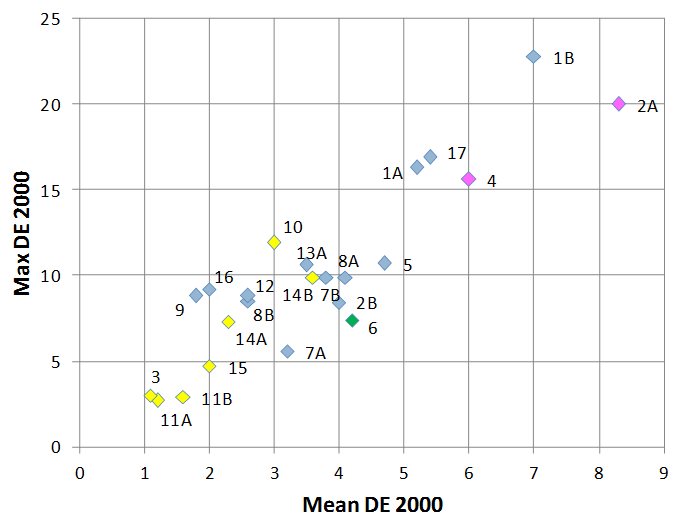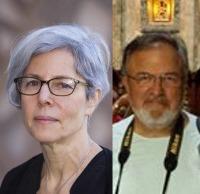Robert Buckley and Melitte Buchman are members of CIE TC8-15 – Archival Colour Imaging Technical Committee where Melitte is the Chair.
CIE TC8-15 is the CIE Technical Committee on Archival Colour Imaging. Overall the CIE is a technical, scientific and cultural non-profit organization in the field of light and lighting, encompassing fundamental subjects as vision, photometry and colorimetry. What does this have to do with the DPC and digital preservation? To the DPC, digital preservation refers to the series of managed activities necessary to ensure continued access to digital materials for as long as necessary. Basic activities are the good capture of physical originals and keeping the digital data safe and secure. CIE TC8-15 exists in the zone where the two organizations overlap for the accurate capture (or digitisation) of colour originals.
The TC’s Terms of Reference are “to recommend a set of techniques for the accurate capture, encoding and long-term preservation of colour descriptions of digital images that are either born digital or the result of digitising 2D static physical objects including documents, maps, photographic materials and paintings.”
Digitisation enables access. Increasingly scholarship is done online through the use of digital surrogates, which for the purposes of research need to be accurate renderings of the originals they are standing in for. Digitisation is one of the key components in enhancing the visibility and accessibility of historic documents, prints and photographs and a major activity in cultural heritage institutions everywhere. This led UNESCO to issue its 2015 Recommendation concerning the preservation of, and access to, documentary heritage including in digital form.
While TC8-15 is focused on capture, access means rendering and reproduction. The omission of reproduction in the TC8-15’s Terms of Reference is deliberate: decoupling capture from reproduction is based on the premise that an archived image (the captured data) will serve as a common, use- and institution-neutral starting point for diverging and differing media- and organizational-specific rendering decisions downstream, now and in the future. So while users and institutions cannot predict future rendering needs, objectives or technologies, they will be able to rely on a known and well-defined starting point—the output of an accurate color capture. This starting point is the object of TC8-15’s investigations.
In evaluating the capture, the assumption is that in accurate colour capture, the digital file will have the same CIE colorimetric values as the original. This is usually the goal of characterizing the capture process, although practitioners describe how they are required to make modifications when, for example, the scan of a vellum original came out too pink because capture devices are not surrogates for the human visual system although their outputs are meant to be surrogates of the colour originals they capture.
TC8-15 is using a dataset based on the image files produced by 17 cultural heritage institutions from the capture of a common set of 7 originals—three test charts and four 19th and 20th century prints. These files are the products of a range of colour encodings, capture devices and methodologies and a rich source of data for the analysis.
To assess the colour accuracy of the capture process, the colour values in the image file for the patches in the test charts and regions of interest (ROI) for the prints were compared with the colour values of the patches and ROIs in the original measured in a lab using a spectrodensitometer. A colour error was calculated using one of the CIE colour difference formulas. The following figure shows preliminary results from plotting max vs. mean colour error from all institutions for the patches on one of the test charts. (Plotting 90 percentile vs. mean is in the TC8-15 work plan.)

As anticipated, the plot shows a range of performance across institutions. A single approach to colour capture is not expected nor desired to meet the needs of all institutions in all cases. Practitioners are more interested in a cost-benefit analysis that will allow them to make an informed choice about capture methodology based on their particular mix of skills, budget, equipment, materials and schedule. Among other things, the TC8-15 study is intended to describe the accuracy-cost tradeoff so that an institution will be in a position to confirm or select a performance point that meets their requirements within their constraints
The output of TC8-15 will be a Technical Report issued in late 2019 or early 2020. This report will complement ISO/TR 19263-1:2017 (Best practices for digital image capture of cultural heritage material), ISO/TS 19264-1:2017 (Image quality analysis for Reflective originals), the FADGI Technical Guidelines for Digitizing Cultural Heritage Material and the Metamorfoze Preservation Imaging Guidelines, all of which contain metrics and aims for colour accuracy. The report will make it possible to compare the aims in these specifications and guidelines with the different capture methodologies.
